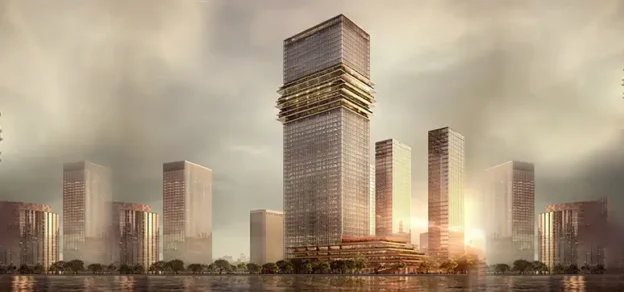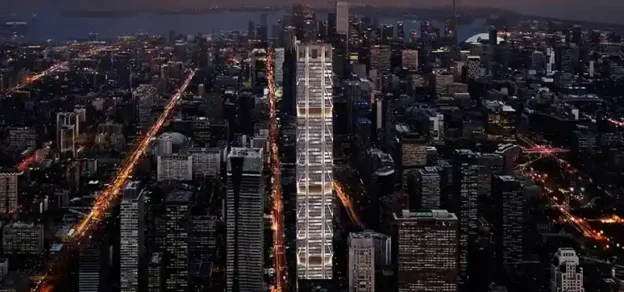Kohinoor Square Tower, Kohinoor Group, Mumbai
Kohinoor Square Tower, Kohinoor Group at Mumbai, India is planned as a mixed-use commercial high-rise tower. The source of inspiration for the design concept is the meaning of the name Kohinoor: mountain of light. Kohinoor is also the name of the largest diamond in the world -the hardest substance found in nature.
At 52 stories, one of the towers will be among India’s tallest office buildings. The structure comprises a concrete core and post-tensioned concrete slab and spandrel beams. The tower’s design objectives challenge the typical glass office building with the abstract pattern created by diamond geometry and triangulation. The triangular shapes are layered onto the building’s mass and façades, through clearly defined planes and opposites: void and solid, opacity and transparency. The glass surfaces of the Kohinoor Square Tower are an abstract pattern inspired by the geometry and triangulation of a diamond. Technological breakthroughs for Indian construction practices are being achieved in structural design, life safety code concepts and sustainability.
The façade of the central tower.
A commitment to environmental consciousness is demonstrated with sustainable features including; rainwater harvesting, black water and grey water treatment, bio walls in vegetated indoor sky gardens, double façade curtain walls and more to meet Gold certification requirements of the Indian Green Building Council. US-based gkkworks’ is the architectural consultant for the design of this building.
The Façade
The façade consists of faceted unitized aluminium curtain walls with provisions for high-performance double glass façades on the tower. The towers are linked by a podium with a façade of custom point-supported glazing on speciality steel trusses.
All the Glasses are articulated glasses and can sustain design wind pressure of 4.5 to 5.0 kpa. Diamond edges of the building having aluminium flashing with LED lighting are the unique feature and make it a complicated façade design. The façade consists of façade LED lighting in the spandrel panel which gives a dynamic look in the night. The Central Tower – CW 1 – is articulated with vision and spandrel glass panels.
Advantages of Unitized Glazing
The proposed system is a ‘fully unitized’ four-sided structural glazing system. The façade is straight in plan in the majority of the area with articulated glass in vision and spandrel. A unitized system with a split mullion and split transom would be installed. The Unitized Panel with 15 mm vertical movement would accommodate floor movement, slab edge deflection, building creep and thermal expansion at every floor unit. No scaffolding is required for unitized panel installation. This is done by floor crane/panel hoisting. Hence the installation is very fast at the site and the time taken is the least by the façade contractor. Cast in the channel for bracket fixing will reduce installation time for the façade contractor at least by one month.
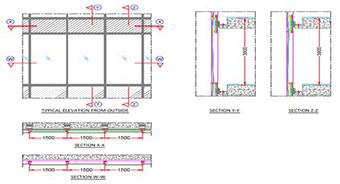
Other Features:
- Units of one grid bay x one-floor height factory finished (1.5x 3.9)
- Pressure equalized drainage system.
- Three barrier weather gasket system.
- Microwave-cured EPDM gaskets for better performance.
- Exposed gaskets of Silicon gaskets for better UV resistance and performance.
- Continuous drainage on every floor.
- The complete unitized panel is factory finished under controlled condition
- Special process of structural glazing in controlled factory condition
- Glass totally free from stresses as glass held by structural sealant
- Economical design with advanced technology
- Complete split mullion and split transom profile becomes structural value hence optimized material content
The building would have a better-performing system since factory-finished elements are used. A more advanced curtain walling system is also being installed. The articulations of the panels are very unique which would give the panel architectural intent to give an iconic look to the project, symbolizing the future of India.
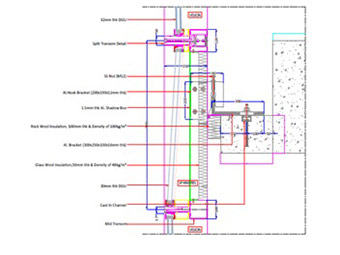
Technical Design Criteria
As per the RWDI report, the design wind pressure is 175 – 525 kg/m2. Structural member deflection would be limited to L/175. Mullion supporting 3m height of vision glass shall not be allowed to deflect more than 17mm. The edge deflection of vision glass needs to be limited to 17mm hence support members shall have more stiffness. Structural calculations are in line with Australian standards for more permissible stress i.e. 1.33 per cent permissible. Vision glass as DGU of 32mm (8mm HS +16mm Air gap +8mm HS) is used as per wind pressure requirement to limit the deflection at the center of the glass to 24mm maximum. Glass flatness during processing of glass i.e. Heat strength and DGU making shall not exceed 3mm of the longer side. Toughening roller wave shall be parallel to the width of the glass.
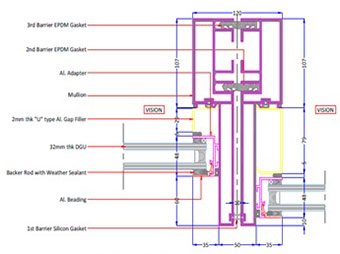
Glass Used
The type of glass used was Spandrel glass as DGU of 30mm (6mm HS + 18mm Air gap + 6mm HS) and Vision glass VLT –-36 per cent, SHGC between 0.23, U value of 1.5 W/m2.k (BTU 0.26). As per architectural intent, a Grey appearance of glass was used. The glass was selected on the basis of higher external Reflection value & Lower internal reflection value. The glass deflection in four side support conditions is limited to L/90 or a maximum of 24mm. The Atrium glass is supported on patch fitting and spider fitting limiting glass deflection is to be L/60 of longer span or 25mm maximum. For the Perforated aluminium structural member deflection is limited to L/175 and for the perforated aluminium panel deflection limiting to L/60.
Glass – Facts
Manufacturer: SYP Glass
Processor: SYP Glass
Glass Makeup: 8mm HS low E coating + 16mm AG + 8mm clear HS
U- Value: 1.41 Watt / Sq m.K
Standard Glass Panel Size: 3900mm (H) x 1500mm (W)
Standard Glass Size: 2943mm (H) x 1443mm (W)
Design Wind Pressure: 3.0 kpa to 4.0 kpa
Glass Density: 2500 kg/cum
All glass Values tested in Singapore Lab
Aluminium – Facts
Aluminium Grade: 6063 T6
Extruder: SAPA India, Gulf Extrusion Dubai
Design Wind Pressure: 3.0 kpa to 4.0 kpa
Density: 2800 kg/cum
Aluminum Consumption in CW1: 14.5 kg/ sq m
Technical Details
| Main Façade Glazing system : | Unitized |
| Glass support system : | Structural silicone glazing |
| Additional glass support at the top & bottom: | Mechanical holding |
| Aluminum Profile finishes : | PVDF (Silver Grey Smith) |
| PVDF Supplier : | PPG REF: 10605 Grey Silver Smith |
| PVDF Thickness : | 35 to 40 microns |
Vision & spandrel Glass deflection criteria
| Center of IGU glass : | Up to 24mm for Design Wind Pressure |
| Design Wind Speed : | 44m/sec |
Material Suppliers / Make
| Glass : | SYP, China |
| Aluminium : | Gulf Extrusion, Dubai |
| Sealants : | Dow Corning |
| Fire sealants : | Hilti |
| Anchor fastners : | Hilti |
| Cast in channel : | Halfen |
| Rockwool : | UP Twiga |
| Window hardware : | Securistyle, Alualpha |
| Pvdf coating: | PPG |
Number game Central Tower
| Aluminium Basic Cost : | Rs.200.00 /kgs |
| Glass basic Cost : | Rs.2400.00/sq m |
| The glass landed Price (at Site) : | Rs.3410.00/sq m |
| System Cost (Ex. Glass) : | Rs.9125.00/ sq m |
| Central Tower Curtain Wall Area : | 38865 sq m |
| Central Tower Floor Area : | 101620 sq m |
| Central Tower Façade Cost : | Rs.48,83,74,654/- |
| Cost per Sq m of Façade Area : | Rs.12566/ sq m |
| Cost Per Sq m of Floor Area : | Rs.4806 / sq m |
| Total Number of Panels : | 6700 panel |
| Panel Installation Start : | 01.12.2011 |
| The maximum achieved / day : | 30 panel |
| Standard Panel Size : | 1500×3900 (mm) |
| Maximum Size of Panel : | 1500×5500 (mm) |
Quick Facts
Project: Kohinoor Square Tower
Location: Mumbai
Client: Kohinoor Group
Concept Architect: gkk Works
Façade Concept: gkk Works
Project Architect: SSA
Façade Consultant: FITI







